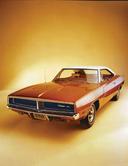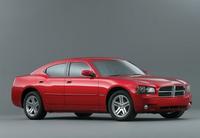2006 Dodge Charger Review and Feature Story
By Thom Cannell
SEE ALSO: New Car Buyer's Guide for Dodge
Charger is In The House—and on the track—after a 28 years absence. If you’re a mid-aged boy-child—Charger’s target market—Dodge and chicks were primo teen-aged fantasies. While there are some visual links to your memories, the 2006 Dodge is definitely not a retro-recreation.
 1969 Dodge Charger |
In the ‘70s, when Charger knocked heads with Ford and Chevy on the NASCAR and drag racing circuits, few buyers actually purchased the 426 cubic inch Hemi engine-equipped cars. They were monsters and got abysmal fuel economy. The joke was “gallons per mile.”
Today’s DaimlerChrysler Multiple Displacement System (MDS) equipped V-8 engines seamlessly alternate between four and eight cylinders to improve real world fuel economy by a claimed 20%. Dodge is selling Hemi-equipped vehicles as fast as engines can be produced. Of five Charger models, three utilize that MDS-equipped V-8 Hemi, and two use a 250 hp. 3.5-liter V-6. Like the old Charger, you can get all the prestige and lower insurance premiums by sacrificing a few horsepower.
Charger is a handsome beast, sure to attract buyers intent on American Muscle at a relatively affordable price, starting at $22, 995 including destination. All models use the advanced independent suspension architecture that debut on Chrysler 300 and Dodge Magnum. It’s well tested and inspired by Mercedes-like thinking. Simply, the chassis is solid, robust and precise. With rack and pinion steering it delivers a connection to the road that you really should experience. Quietness of this full-sized car is admirable; at speed the loudest sounds are muffled tire noise and the ventilation system.
Beginning the Charger experience with a basic SE, my initial impressions included very supportive seats with decent side bolster support, lumbar and micro-tilt seat back adjustment, and a steering wheel that both tilts and telescopes. These features made it easy to find a very comfortable driving position.
Other notable standard features are Electronic Stability Program with brake assist and all-speed traction control. Comfort features include exterior temperature display, ABS, power locks and mirrors, and speed control. While the exterior view is dominated by massive A-pillars, their placement does not block too much of your view, thanks to a highly sloped windscreen.
The other V-6 model, SXT, upgrades the stereo to a 276-watt digital amplifier and substitutes six Boston Acoustics speakers. SXT adds a leather wrapped steering wheel and shift knobs, remote exterior mirrors, 8-way power drivers seat, and a chrome grille. This bumps MSRP to $25,995 including destination. Larger P225/60R 18 wheels and tires are optional. Compared to an original Charger, the 250 horsepower and 250 pound-feet of torque in SE and SXT provides more power and performance than the old 318 cubic inch V-8.
There are three Charger V-8 models, R/T, R/T with the Road and Track tuning package, and the Daytona R/T. With R/T you get a 340 horsepower Hemi mated to the AutoStick five speed transmission (the only transmission) and suspension calibrated for “performance and spirited driving,” according to Dodge. Adding the Road and Track package (CODE AWT) tightens up the steering response, adds self-leveling dampers Chrysler calls “Nivomat™,” and performance suspension, plus improves seat bolstering. Tuning the intake and exhaust bumps this Hemi’s horsepower by 10 to 350 horsepower. The R/T Road and Track (any one sense some confusion?) rides on 18” all-season Michelin tires and polished aluminum wheels with black painted pockets. The R/T is priced at $29,995.
 |
Mingling with other Chargers on our way to Virginia International Speedway, we could appreciate how cool the vehicle looks on the road.
 |
Every Charger we drove exhibits plenty of power and very tasty road manners. Steering is ultra-precise; the five-speed AutoStick automatic transmission (there are no manual transmissions offered) downshifts promptly and does not require crushing the floorboard to downshift. The downfall, if any, is steering effort that is too light, in my opinion.
In an attempt to answer criticism that on highly crowned roads too much muscle is required to keep the vehicle going straight, steering effort has been reduced to the point where a good sneeze, a glance at the radio or rear seat passenger (we all do it) could result in significant lane deviation. How shall I put it? Imagine Heinz catsup or blackstrap molasses pouring like vinegar. Not enough body – not enough resistance or tension.
 |
My concern, echoed almost universally, is that the interior is entirely engineered plastic, no matter the price level. There’s no perforated leather door panels, fabric inserts, or bright trim. The best you can hope for is upgraded seats with perforated suede leather inserts on the Daytona R/T. That’s just not acceptable in the $25,000+ price range. In comparison a fully equipped Charger R/T Daytona is priced at $32,495, close to a BMW 3 Series and other entry luxury cars. They, of course, do not have a 345 thumping horsepower V-8 with twin exhausts and characteristic rumble.
Granted the opportunity to wring out both Charger R/T and Daytona R/T, we donned helmets and were turned loose on a racetrack.
Virginia International Raceway is a very fast track and I hit over 120 mph at the end of the front straight (how much more I don’t know, a right-hand hairpin occupied my thoughts.) Top speed is pure conjecture, but mash the accelerator and 100 MPH comes up fast! This Hemi has every one of its 350 horses available for butt-kicking propulsion.
On highway or track, brakes were fade-free and it was easy to apply precise stopping power. Despite repeated laps by racer-wannabe journalists with more courage than skill, there were no incidents of brake fade. Chassis flex or bend was simply nonexistent, and the transmission could be left in Drive or manually shifted at your desire. Leaving the tranny in Drive is more like brisk—really really brisk—daily driving.
VIR has significant elevation changes mixed in with blind turns. Those kinds of challenges really define a car. Do you feel confident, or not? The Charger inspired confidence. Interestingly, though the Daytona R/T had better seats with the sticky suede inserts, the R/T was just as much fun to drive. Perhaps that was because as the “ordinary” vehicle there was no expectation of heroism and drivers let the vehicle do the shifting. Regardless, either vehicle had solid performance. And while what happens on the track has little to do with real world driving, it does expose flaws. Where else are you maximally braking from 120, repeatedly? Where else are you braking, turning, and climbing a steep hill (which collapses suspension) at the same time? If a car feels safe on the track, it feels four times safer on the road.
With five models, plus an outrageous SRT8 6.1-liter 425 horsepower version yet to come, Charger’s lineup fits most households and budgets. It seats five in comfort and that’s five American adults. Ride and handling, other than light steering, is up to the quality of European imports. Style-wise, it’s hard to identify a better looking car. Interiors, while handsome, are light on luxury, heavy on functional design. Under the hood you couldn’t wish for more: two V-6s—SE and SXT—three V-8s and every one’s “Got a Hemi.”
You can reach the author at CannellAndAssociates@comcast.net



